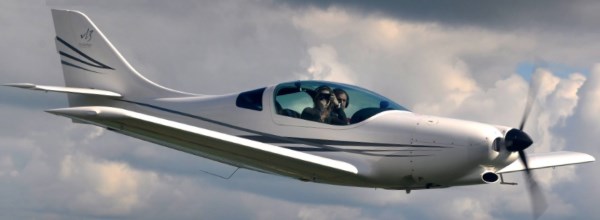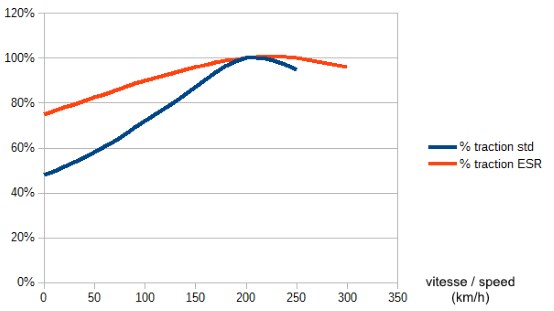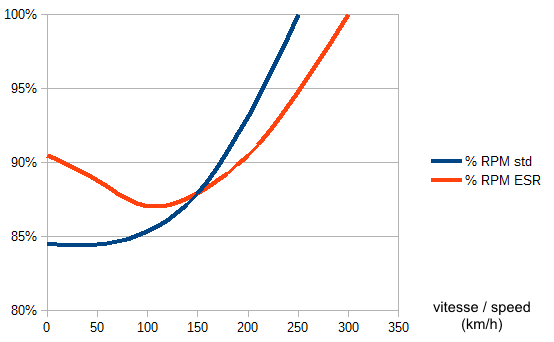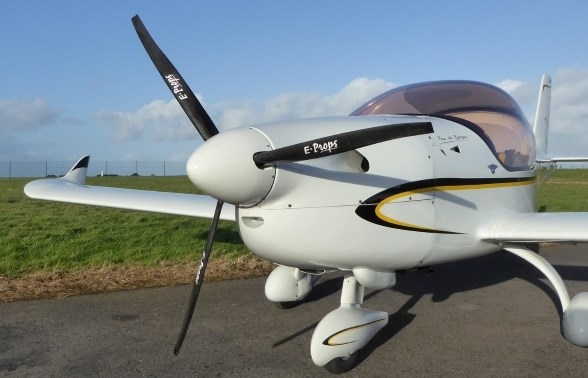EXTENDED SPEED RANGE (ESR) EFFECT
At E-PROPS, we are using the term "ESR effect" (Extended Speed Range effect) to define a fixed pitch propeller (or ground adjustable pitch one) which behaviour is very near from the behaviour of a variable pitch propeller.
This ESR effect has the following characteristics : it causes very small gap between the static RPM and the flight RPM, and this allows to keep a strong power at take-off.
It means that the max throttle RPM stays nearly constant.
For example :
- take-off : engine full throttle 5400 RPM
- max speed 200 km/h : engine full throttle 5500 RPM
In this case, the gap between 0 km/h and 200 km/h is only 100 RPM.
For comparison purposes, a standard propeller (not ESR) can have a gap up to 1000 RPM between take-off and max cruise speed.

very fast aircraft : JMB VL3 with Rotax 912S
Example for a ROTAX 912 engine, pitch adjusted for 5800 RPM at 120 km/h :
- a propeller without ESR Effect will have between 600 and 1000 RPM less at take-off, and its thrust will be lower than 185 kg.
- an E-PROPS with ESR effect will allow to have only 200 RPM less at take-off (5600 RPM) : it means a static thrust of 210 kg (10 % more!)
The ESR effect can improve the performances at take-off, because then the engine is running very near of its max RPM, and provide all its power during take-off.
Some E-PROPS models allow to have more RPM at take-off than in flight...
From technical point of view, there are different solutions to obtain this ESR effect :
- narrow chord with classic profiles
- pitch reduction at low speed by blades deformation (difficult to obtain)
- narrow chord with special profiles, in order to avoid the stall of the blades => it is the case of the E-PROPS
COMPARATIVE CURVES (THRUST and RPM)
between an E-PROPS ESR effect propeller and a standard propeller

in thrust % (100% = an optimal variable pitch propeller)
the thrust of the E-PROPS propeller with ESR effect is always above the thrust of a standard propeller

indicated RPM in % of the maximum engine RPM during take-off,
the RPM of the E-PROPS propeller with ESR effect is always above a standard propeller
Do not forget : what makes aircraft taking-off, it is not engine RPM but propeller thrust
between an E-PROPS ESR effect propeller and a standard propeller

in thrust % (100% = an optimal variable pitch propeller)
the thrust of the E-PROPS propeller with ESR effect is always above the thrust of a standard propeller

indicated RPM in % of the maximum engine RPM during take-off,
the RPM of the E-PROPS propeller with ESR effect is always above a standard propeller
In the case of stalled blades, the loss of performance may be higher than the power gain.
Therefore, optimization of the curve "max traction / speed" is essential when designing the propeller.
When attempting to reduce an aircraft’s take-off distance, traction between 40 and 80 km/h is much more important than that between 0 and 40 km/h :
- while the aircraft is increasing from 0 to 40 km/h, its average speed is only 20 km/h; the distance made remains low (ex: 16 m in 3 sec)
- between 40 and 80km/h, the average speed is 60 km/h: this is where the runway length is "consumed" (ex: 60 m in 3.5 sec)
It also means that, on E-PROPS, the static thrust is not an important data.
Thanks to their geometries anf their profiles, the E-PROPS have a very strong ESR effect, which allows to considerably improve the performances of the aircraft at take-off and in cruise, in comparison with all standard fixed pitch, and even with some variable pitch propellers.

a ground adjustable pitch E-Props propeller better than an inflight variable pitch propeller
For example, see the Comparative Test Report : E-PROPS / Variable Pitch Model
See many other tests reports showing the ESR effect here : E-PROPS : TESTS IN FLIGHT
